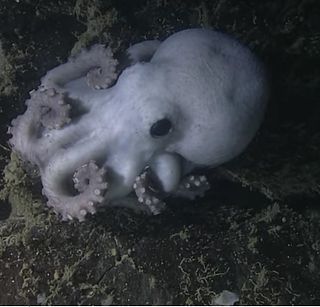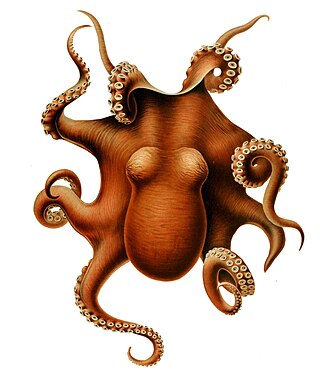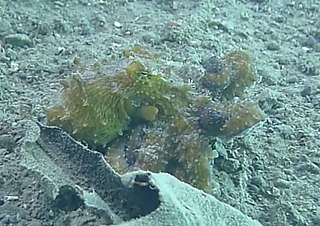
The Octopodidae comprise the family containing the majority of known octopus species.

Enteroctopus is an octopus genus whose members are sometimes known as giant octopuses.
Mark Douglas Norman is a scientist living in southern Australia. He works as a Chief Conservation Scientist with Parks Victoria.

Bathypolypus is a genus of octopuses in the monotypic family Bathypolypodidae.
Thaumeledone is a genus of octopuses in the family Octopodidae found in deep waters in the Southern Hemisphere.
Abdopus is a genus of octopuses in the family Octopodidae.

Enteroctopus megalocyathus, also known as Patagonian red octopus (EN), Pulpo del sur (Chile) and Pulpo colorado (Argentina); is a medium-sized octopus, and the type species for the genus Enteroctopus.

Amphioctopus is a genus of octopuses comprising around 16 species.
Graneledone yamana is a species of octopus in the genus Graneledone. G. yamana is assigned to this genus because of the absence of an ink sac and crop, the presence of cartilaginous warts covering the body cavity, uniserial suckers on the arms, and a reduced radula. This genus has been found in the deep waters of the Atlantic Ocean near hydrothermal vents. Its identifying characteristics are papillose skin, two horns located above the eyes, small gills, and five to seven lamellae located on the outside of the demibranch. The arms of G. yamana have 35–80 suckers on the females and 26–70 on the males. This species is known from the southwest Atlantic Ocean off the coasts of Uruguay, Argentina, and southern Brazil. G. yamana is the fifth species of Graneledone found in the southern oceans. G. yamana physically resembles the species Graneledone verrucosa, except the cartilaginous warts on the body cavities of both these species differ. G. verruscosa is also found in the North Atlantic Ocean instead of the South.
Aggregata is a genus of parasitic alveolates belonging to the phylum Apicomplexa.
Histoctopus is an octopus genus containing two species: Histoctopus zipkasae, the type species, and Histoctopus discus. The former is found in the south-west Pacific Ocean while the latter is found in the Indian Ocean. The three taxa were described in 2009 by Mark D. Norman, Renata Boucher-Rodoni and F. G. Hochberg in the Journal of Molluscan Studies. The genus name is derived from octopus and the Greek word histos, meaning "web" or "tissue", in reference to the membrane on the outside of the arms. The type species was named zipkasae, "after the senior author's wonderful wife, Karen Zipkas", while the name of H. discus comes from the Latin discus, meaning "plate", in reference to the large suckers.

Megaleledonidae is a family of octopuses in the superfamily Octopodoidea. It was formerly placed in the family Octopodidae sensu lato as the subfamily Megaleledoninae but more recent studies have raised this taxon as a valid family.
Microeledone mangoldi, the sickle-tooth pygmy octopus, is a species of octopus from the family Megaleledonidae. This species was described in 2004, the type specimen being a male which was collected from a depth of approximately 1,000 m (3,300 ft) near the Norfolk Ridge, in the southwest Pacific Ocean near New Caledonia. It is a very small octopus which has a single row of suckers, lacks an ink sac and has a radula with seven rows of teeth with the unique central tooth, called the rechidian tooth, being curved with a grooved tip. The remaining teeth are flat and plate like and so are also distinctive. The smooth creamy-pink body lacks any chromatophores. The specific name honours the Swiss malacologist and marine biologist Katharina Mangold-Wirz (1922-2003).

Muusoctopus is a cosmopolitan genus of deep-sea octopus from the family Enteroctopodidae. These are small to medium-sized octopuses which lack an ink sac. Recent work has suggested that these octopuses originated in the North Atlantic and subsequently moved into the North Pacific while the species in the Southern Hemisphere are descended from multiple invasions from northern oceans.
Sasakiopus is a genus of octopus containing only one species, Sasakiopus salebrosus, the rough octopus. It is part of the family Enteroctopodidae. Genetic analysis appeared to show that S. salebrosus is the sister taxon of the genera Benthoctopus and Vulcanoctopus, although the former is now considered a synonym of Bathypolypus, the only genus in the family Bathypolypodidae, and the latter as a synonym of Muusoctopus.
Cistopus is a genus of octopuses in the family Octopodidae from the Indo-Pacific region, colloquially known as old-lady octopuses. For a long time it was thought that Cistopus was monotypic with the type species, C. indicus, being the only known species. This species was characterised by the possession of eight small mucus filled pouches around the animal's mouth in the web between the bases of each arm, these have an opening which releases the mucus. The function of these pouches is unknown. A new species, C. taiwanicus was described in 2009 from Taiwan. Octopuses in the genus Cistopus are harvested and utilised for food on a commercial basis in southern and eastern Asia. Further new species have been described since then.
Galeoctopus lateralis, the sharkclub octopus, is a species of octopus, from the family Octopodidae. This species was described in 2004 from specimens collected at depths of 200–400 m in the southern and western Pacific Ocean. It is a small octopus in which the mature males have a distinctive ligula which superficially resembles a shark's jaw and head including teeth‐like lugs. Other distinguishing characteristics include a lateral mantle ridge, a skin sculpture which includes star-shaped papillae, and the females have oviducts with hare distally swollen.
Octopus oliveri, is a species of octopus found in the western Pacific Ocean off the coast of Japan, Hawaii, and Kermadec Island, in reefs and boulder coasts.

Octopus insularis is a species of octopus described in 2008 from individuals found off the coast of Brazil, with a potentially much larger range.

Abdopus abaculus, or the mosaic octopus, is a species of pygmy octopus. It was first described as Octopus abaculus by M. D. Norman and M. J. Sweeney in 1997 based on specimens caught in Zamboanga del Norte, Philippines.









